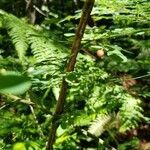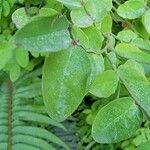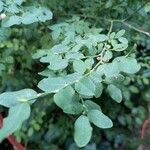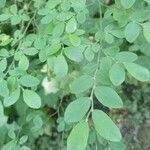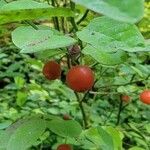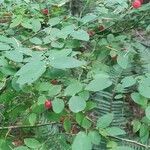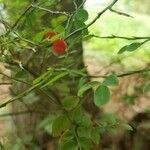Plants crown-forming, some-times suckering when injured, 10-70 dm, not rhizomatous; twigs of current season green, sharply angled, glabrous or minutely puberulent in lines; (short lateral branches on both orthotropic and plagiotropic shoots often divaricate to 75° giving shrub a distinct fasciculate aspect). Leaf blades dark green, ovate to oblong-elliptic, 13-25 × 8-14 mm, margins entire, surfaces puberulent or glabrous abaxially, glabrous adaxially. Flowers: calyx pale green, lobes spreading, distinct, broadly ovate, 0.4-0.6 mm, glabrous; corolla pink, bronze, or yellowish green, globose to urceolate, 4-6 × 3-5 mm, thin, glaucous; filaments glabrous. Berries red, sometimes faintly glaucous, translucent, 7-10 mm diam. Seeds ca. 1 mm. 2n = 24.
More
A shrub. It grows 1.8 m high and spreads 1.8 m wide. It loses its leaves during the year, but can keep its leaves in warmer climates. The leaves are 25 mm long. They are light green. The flowers are 6 mm wide. They are green with red tints. The fruit are pinkish-red berries. They let light through. They are 1.25 cm across. They are edible. They contain about 20 seeds.
Coastal forests. Moist to dry, conifer and mixed conifer-hardwood forests, often on stumps and logs, disturbed areas, roadsides; at elevations from sea level to 1,100 metres.
More
It is a temperate plant. It does best with light shade. It grows in rocky hillsides in Alaska. They are cold hardy. It suits hardiness zones 6-10.
